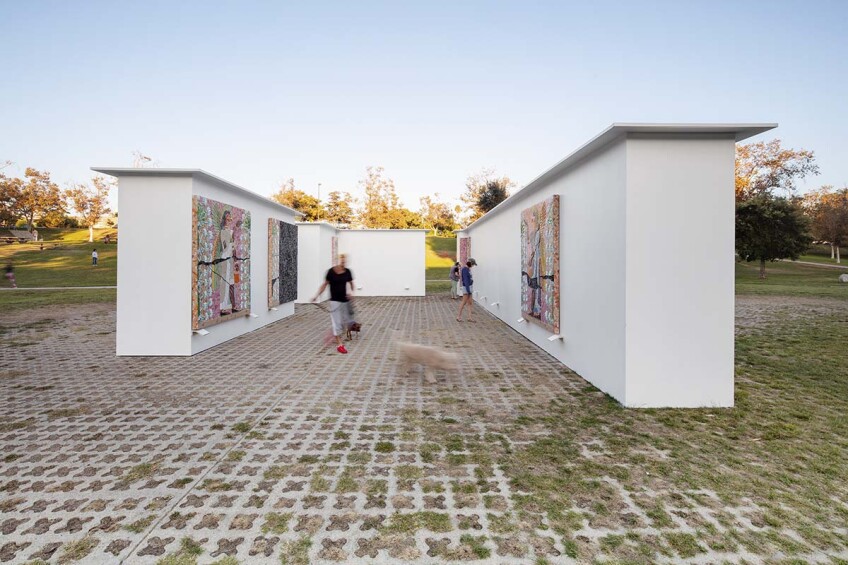Michael Rakowitz Reconstructs and Recaptures Iraq's Treasures at the Park

Current:LA Food is a city-wide triennial presenting art projects by 15 national and international artists and teams, who have taken on the global issue of food. See Currrent:LA Food all over the 15 council districts of Los Angeles. This article was made in partnership with The City of Los Angeles Department of Cultural Affairs (DCA) and the Institute of Contemporary Art, Los Angeles (ICA LA). Find out more about Current:LA Food on our coverage here.
Michael Rakowitz, the internationally-acclaimed Iraqi American artist, wants to “fill diners’ stomachs while also turning them” at his new installation in Pan Pacific Park titled, “Beneath the Date Palms.”
As part of his deep interest in contrasts, right now, he's focusing his art at “working at the intersection between hospitality and hostility.”
Diners need not fear, however, as he plans to accomplish this by serving food centered around the concept of helou and hamid, sweet and sour.
“If you make a kubba dumpling that has a sweet flavor, you cook it in a stew that is sour — and vice versa — so that the flavors are held in a space of tension,” he explained. “That space is where I locate my work.”
“Beneath the Date Palms” is essentially a reconstruction of Room F in Iraq’s Northwest Palace of Nimrud, and when visitors walk alongside its halls, they will notice that some spaces along the walls have captions below them but have no reliefs or panels above. This is no mistake, as Rakowitz wants visitors to think deeply about why that is.
“Beneath the Date Palms” is part of Rakowitz’s ongoing project, “The Invisible Enemy Should Not Exist,” which he started in 2007. The project was originally dedicated to reconstructing the 8,000 or so items listed as missing, stolen or otherwise unknown that were looted from the Iraq Museum in Baghdad during the aftermath of the U.S.-led invasion in 2003. Now, Rakowitz is also reconstructing some of the countless historic sites that were victims of the Islamic State's grand path of destruction and displacement from 2014 to 2016, resulting in "a devastating shared loss" for humanity.
With “The Invisible Enemy Should Not Exist,” Rakowitz is attempting to reconstruct all the rooms in Iraq’s Northwest Palace of Nimrud, brought down to rubble by ISIS in 2015. The rooms are mainly composed of walls festooned with handmade paper mâché reliefs. These reliefs were constructed for months by Rakowitz and his studio team, who painstakingly cut and chose specific pieces of colorful paper.

In this way, Rakowitz tackles a history of migration and displacement that has been going on for hundreds of years. For his family, it started with his Iraqi Jew grandfather’s migration in the 1940s to the U.S., but it is a history we can see today in the plight of Syrian refugees and groups like the Yazidis from Iraq, Syria and Turkey. He sees it as his responsibility to rescue those stories and cultural treasures.
Not all panels have been reconstructed, however, and this is by design. Historically, some panels were taken from the palace and now live somewhere else in the world, namely, other museums. He only rebuilds what was destroyed. In the case of Room F, Rakowitz explained that the removal of the site began long before ISIS destroyed it in 2015. During the middle of the 19th century, western archaeologists excavated the site and took panels and reliefs back to their countries. In a curious coincidence, he said, one of the “siblings” from that room is currently held in the Los Angeles County Museum of Art.
See some artifacts from Nimrud found in museums around the world:






To create what Rakowitz called a “compost of different histories,” the artworks are made using packaging of Middle Eastern foodstuffs sold in the U.S. and the Arabic-English newspapers given away for free and read by newly arrived immigrants to the U.S. from countries like Syria and Iraq. The food packages are especially personal to him because they take him back to the kitchen where he learned to cook Iraqi food from his mother and grandmother.
Besides gazing at reliefs, visitors will get to enjoy dinners featuring California dates in a communal setting within the installation, a reconstructed room of an ancient Iraqi palace, alongside members of Los Angeles’ Iraqi community and Iraq War veterans. Featuring dates in the dinners was a conscious decision. If it weren’t for Iraq’s date palms, explains Rakowitz, California's massive date industry, which started with seeds from Iraqi palms, would be nonexistent. By including dates, he also wants diners to consider the impact geopolitics have in our lives, from the displacement and destruction they create to the more positive exchange of food, not to mention the delicious, caramelly dates we have enjoyed for millennia.
By being made from what diaspora reads and eats, the artworks represent links to those peoples’ past and cultures.
“Material culture of the work presents fragments of cultural visibility and life to create things that are now invisible and dead,” he said.

Top Image: Nimrud Relief from the Neo-Assyrian Period, at the Los Angeles County Museum of Art | rocor / Flickr / CC BY-NC 2.0




